2012 Hyundai Sonata fuel
[x] Cancel search: fuelPage 325 of 363
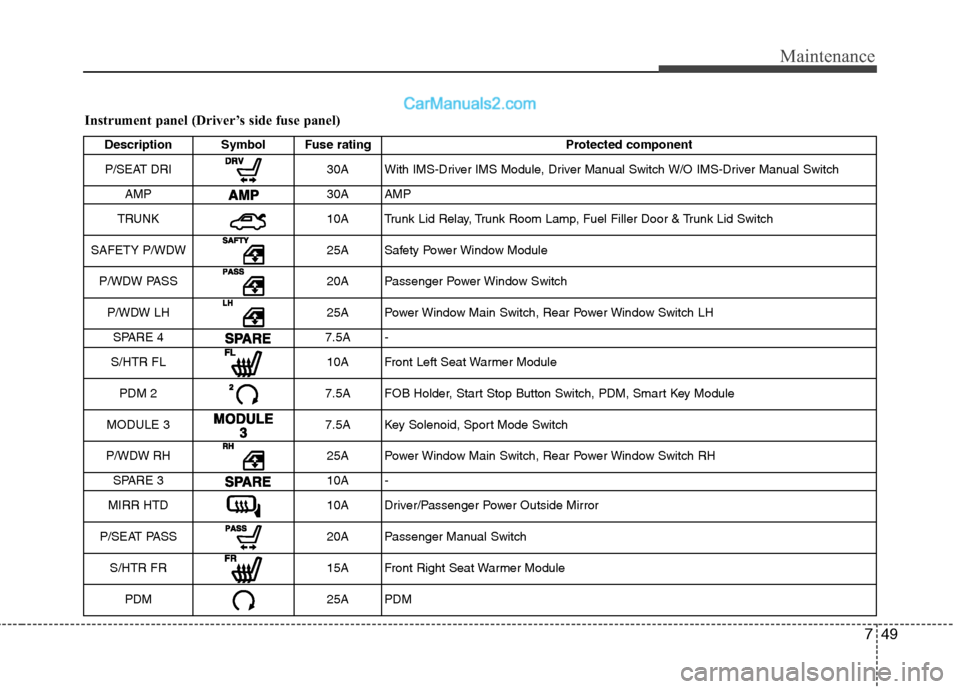
749
Maintenance
Instrument panel (Driver’s side fuse panel)Description Symbol Fuse rating Protected component
P/SEAT DRI
30A With IMS-Driver IMS Module, Driver Manual Switch W/O IMS-Driver Manual Switch
AMP
30A AMP
TRUNK
10A Trunk Lid Relay, Trunk Room Lamp, Fuel Filler Door & Trunk Lid Switch
SAFETY P/WDW
25A Safety Power Window Module
P/WDW PASS
20A Passenger Power Window Switch
P/WDW LH
25A Power Window Main Switch, Rear Power Window Switch LH
SPARE 4
7.5A -
S/HTR FL
10A Front Left Seat Warmer Module
PDM 2
7.5A FOB Holder, Start Stop Button Switch, PDM, Smart Key Module
MODULE 3
7.5A Key Solenoid, Sport Mode Switch
P/WDW RH
25A Power Window Main Switch, Rear Power Window Switch RH
SPARE 3
10A -
MIRR HTD
10A Driver/Passenger Power Outside Mirror
P/SEAT PASS
20A Passenger Manual Switch
S/HTR FR
15A Front Right Seat Warmer Module
PDM
25A PDM
Page 329 of 363
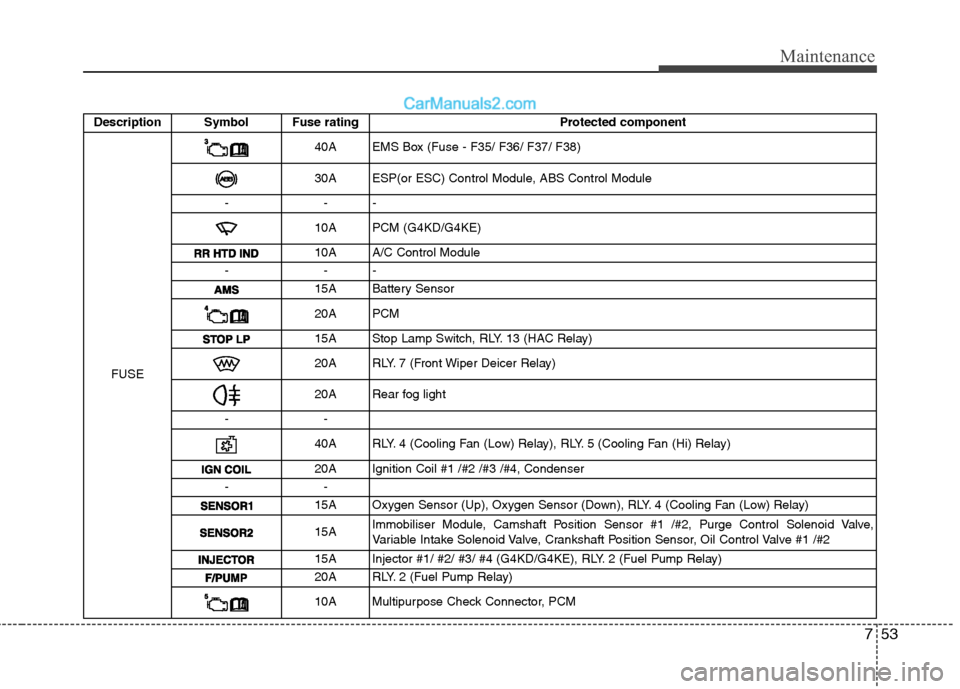
753
Maintenance
Description Symbol Fuse ratingProtected component
FUSE
40AEMS Box (Fuse - F35/ F36/ F37/ F38)
30A ESP(or ESC) Control Module, ABS Control Module
-- -
10A PCM (G4KD/G4KE)
10A A/C Control Module
-- -
15A Battery Sensor
20A PCM
15A Stop Lamp Switch, RLY. 13 (HAC Relay)
20A RLY. 7 (Front Wiper Deicer Relay)
20A Rear fog light
--
40A RLY. 4 (Cooling Fan (Low) Relay), RLY. 5 (Cooling Fan (Hi) Relay)
20A Ignition Coil #1 /#2 /#3 /#4, Condenser
--
15A Oxygen Sensor (Up), Oxygen Sensor (Down), RLY. 4 (Cooling Fan (Low) Relay)
15A Immobiliser Module, Camshaft Position Sensor #1 /#2, Purge Control Solenoid Valve,
Variable Intake Solenoid Valve, Crankshaft Position Sensor, Oil Control Valve #1 /#2
15A Injector #1/ #2/ #3/ #4 (G4KD/G4KE), RLY. 2 (Fuel Pump Relay)
20A RLY. 2 (Fuel Pump Relay)
10A Multipurpose Check Connector, PCM
Page 340 of 363
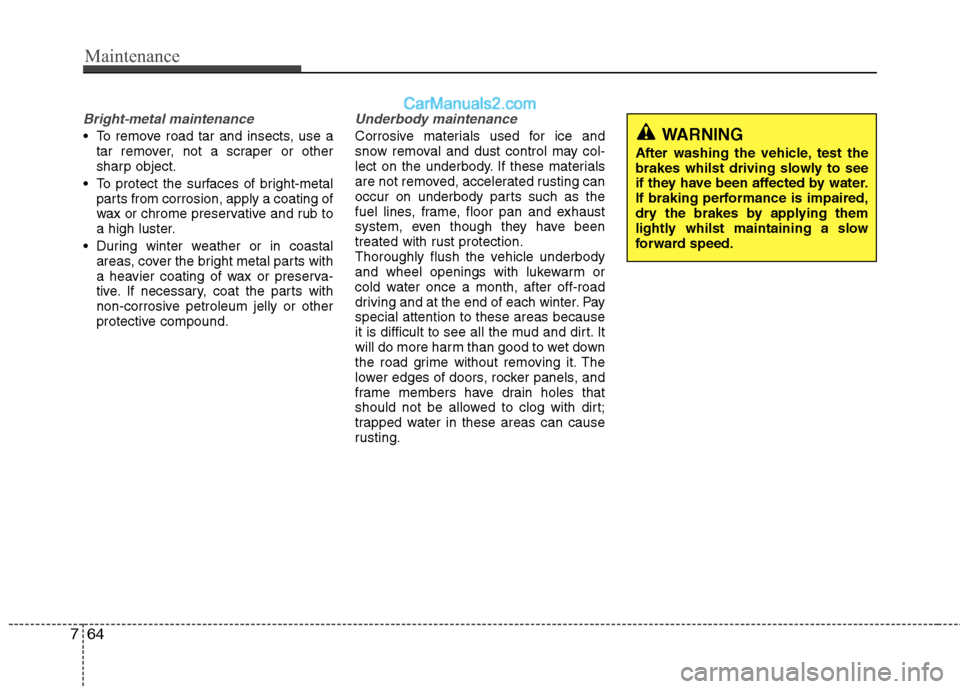
Maintenance
64
7
Bright-metal maintenance
To remove road tar and insects, use a
tar remover, not a scraper or other
sharp object.
To protect the surfaces of bright-metal parts from corrosion, apply a coating of
wax or chrome preservative and rub to
a high luster.
During winter weather or in coastal areas, cover the bright metal parts with
a heavier coating of wax or preserva-
tive. If necessary, coat the parts with
non-corrosive petroleum jelly or other
protective compound.
Underbody maintenance
Corrosive materials used for ice and
snow removal and dust control may col-
lect on the underbody. If these materials
are not removed, accelerated rusting can
occur on underbody parts such as the
fuel lines, frame, floor pan and exhaust
system, even though they have been
treated with rust protection.
Thoroughly flush the vehicle underbody
and wheel openings with lukewarm or
cold water once a month, after off-road
driving and at the end of each winter. Payspecial attention to these areas because
it is difficult to see all the mud and dirt. It
will do more harm than good to wet down
the road grime without removing it. The
lower edges of doors, rocker panels, and
frame members have drain holes that
should not be allowed to clog with dirt;
trapped water in these areas can cause
rusting.WARNING
After washing the vehicle, test the
brakes whilst driving slowly to see
if they have been affected by water.
If braking performance is impaired,
dry the brakes by applying them
lightly whilst maintaining a slow
forward speed.
Page 344 of 363
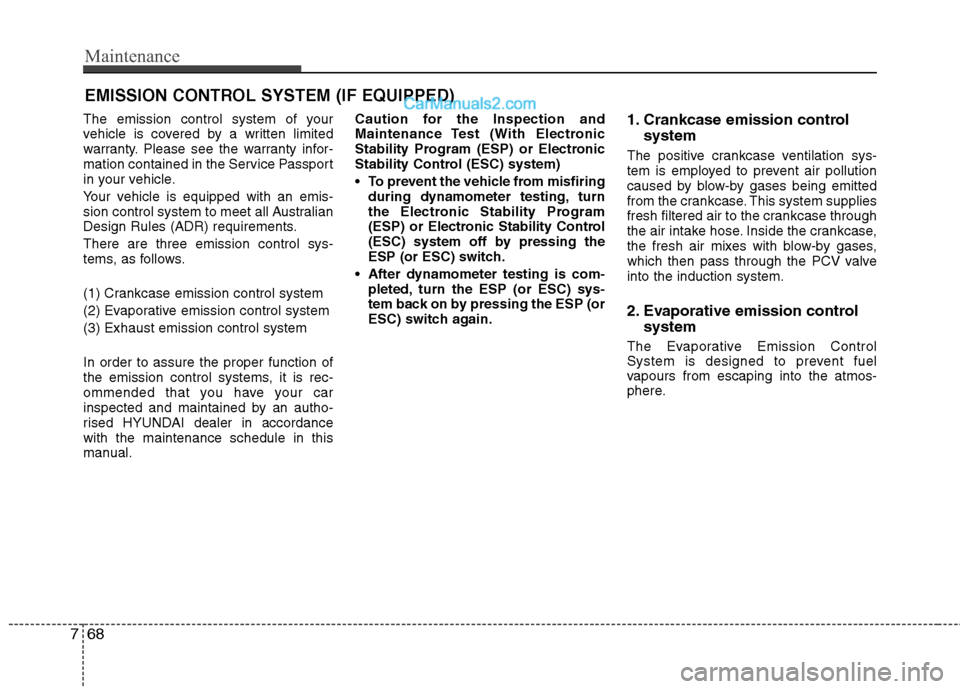
Maintenance
68
7
EMISSION CONTROL SYSTEM (IF EQUIPPED)
The emission control system of your
vehicle is covered by a written limited
warranty. Please see the warranty infor-
mation contained in the Service Passport
in your vehicle.
Your vehicle is equipped with an emis-
sion control system to meet all Australian
Design Rules (ADR) requirements. There are three emission control sys-
tems, as follows.
(1) Crankcase emission control system
(2) Evaporative emission control system(3) Exhaust emission control system In order to assure the proper function of
the emission control systems, it is rec-
ommended that you have your car
inspected and maintained by an autho-
rised HYUNDAI dealer in accordancewith the maintenance schedule in this
manual. Caution for the Inspection and
Maintenance Test (With Electronic
Stability Program (ESP) or Electronic
Stability Control (ESC) system)
To prevent the vehicle from misfiring
during dynamometer testing, turn
the Electronic Stability Program
(ESP) or Electronic Stability Control
(ESC) system off by pressing the
ESP (or ESC) switch.
After dynamometer testing is com- pleted, turn the ESP (or ESC) sys-
tem back on by pressing the ESP (or
ESC) switch again. 1. Crankcase emission control
system
The positive crankcase ventilation sys-
tem is employed to prevent air pollution
caused by blow-by gases being emitted
from the crankcase. This system supplies
fresh filtered air to the crankcase through
the air intake hose. Inside the crankcase,
the fresh air mixes with blow-by gases,
which then pass through the PCV valveinto the induction system.
2. Evaporative emission control system
The Evaporative Emission Control
System is designed to prevent fuel
vapours from escaping into the atmos-
phere.
Page 345 of 363

769
Maintenance
Canister
Fuel vapours generated inside the fuel tank are absorbed and stored in the
onboard canister. When the engine is
running, the fuel vapours absorbed in the
canister are drawn into the surge tank
through the purge control solenoid valve.
Purge Control Solenoid Valve (PCSV)
The purge control solenoid valve is con-
trolled by the Engine Control Module
(ECM); when the engine coolant temper-
ature is low during idling, the PCSV clos-
es so that evaporated fuel is not taken
into the engine. After the engine warms-
up during ordinary driving, the PCSV
opens to introduce evaporated fuel to the
engine.3. Exhaust emission control
system
The Exhaust Emission Control System is
a highly effective system which controls
exhaust emissions whilst maintaining
good vehicle performance.
Vehicle modifications
This vehicle should not be modified. Modification of your vehicle could
affect its performance, safety or dura-
bility and may even violate governmen-
tal safety and emissions regulations.
In addition, damage or performance
problems resulting from any modifica-
tion may not be covered under warran-
ty.
If you use unauthorised electronic devices, it may cause the vehicle to
operate abnormally, wire damage, bat-
tery discharge and fire. For your safety,
do not use unauthorized electronic
devices.
Engine exhaust gas precautions
(carbon monoxide)
Carbon monoxide can be present with other exhaust fumes. Therefore, if you
smell exhaust fumes of any kind inside
your vehicle, have it inspected and
repaired immediately. If you ever sus-
pect exhaust fumes are coming into
your vehicle, drive it only with all the
windows fully open. Have your vehicle
checked and repaired immediately.
WARNING - Exhaust
Engine exhaust gases contain car-
bon monoxide (CO). Though
colourless and odourless, it is dan-
gerous and could be lethal if
inhaled. Follow the instructions on
this page to avoid CO poisoning.
Page 346 of 363
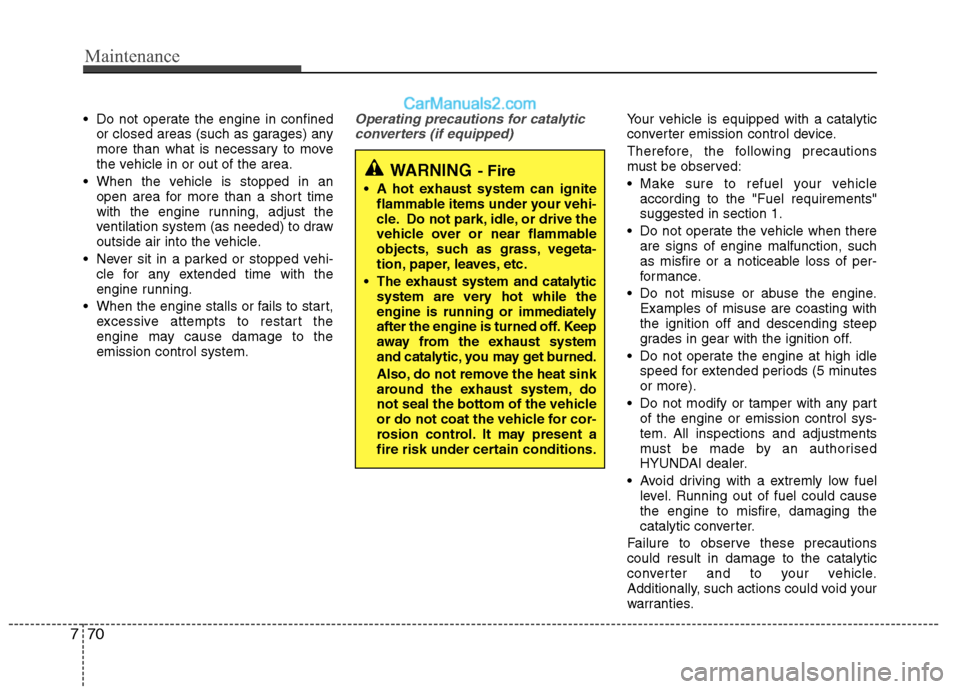
Maintenance
70
7
Do not operate the engine in confined
or closed areas (such as garages) any
more than what is necessary to move
the vehicle in or out of the area.
When the vehicle is stopped in an open area for more than a short time
with the engine running, adjust the
ventilation system (as needed) to draw
outside air into the vehicle.
Never sit in a parked or stopped vehi- cle for any extended time with the
engine running.
When the engine stalls or fails to start, excessive attempts to restart the
engine may cause damage to theemission control system.Operating precautions for catalytic
converters (if equipped)Your vehicle is equipped with a catalytic
converter emission control device.
Therefore, the following precautions
must be observed:
Make sure to refuel your vehicle according to the "Fuel requirements" suggested in section 1.
Do not operate the vehicle when there are signs of engine malfunction, such
as misfire or a noticeable loss of per-
formance.
Do not misuse or abuse the engine. Examples of misuse are coasting withthe ignition off and descending steep
grades in gear with the ignition off.
Do not operate the engine at high idle speed for extended periods (5 minutesor more).
Do not modify or tamper with any part of the engine or emission control sys-
tem. All inspections and adjustments
must be made by an authorised
HYUNDAI dealer.
Avoid driving with a extremly low fuel level. Running out of fuel could cause
the engine to misfire, damaging the
catalytic converter.
Failure to observe these precautionscould result in damage to the catalytic
converter and to your vehicle.
Additionally, such actions could void your
warranties.
WARNING - Fire
A hot exhaust system can ignite flammable items under your vehi-
cle. Do not park, idle, or drive the
vehicle over or near flammable
objects, such as grass, vegeta-
tion, paper, leaves, etc.
The exhaust system and catalytic system are very hot while the
engine is running or immediately
after the engine is turned off. Keep
away from the exhaust system
and catalytic, you may get burned.
Also, do not remove the heat sink
around the exhaust system, do
not seal the bottom of the vehicle
or do not coat the vehicle for cor-
rosion control. It may present a
fire risk under certain conditions.
Page 350 of 363
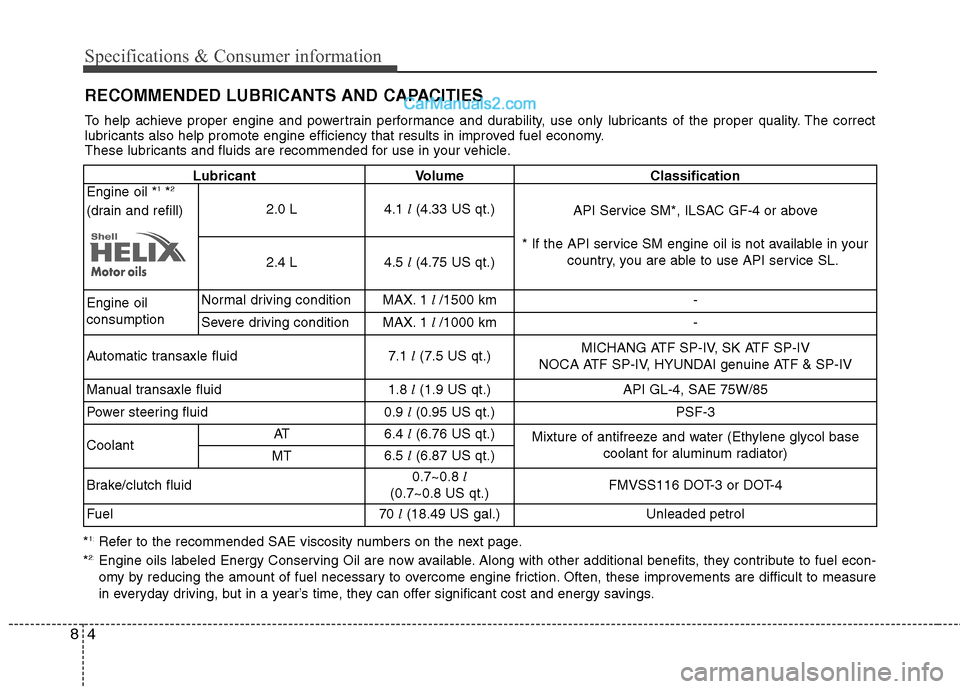
Specifications & Consumer information
4
8
RECOMMENDED LUBRICANTS AND CAPACITIES
* 1:
Refer to the recommended SAE viscosity numbers on the next page.
* 2:
Engine oils labeled Energy Conserving Oil are now available. Along with other additional benefits, they contribute to fuel econ-
omy by reducing the amount of fuel necessary to overcome engine friction. Often, these improvements are difficult to measure
in everyday driving, but in a year’s time, they can offer significant cost and energy savings.
To help achieve proper engine and powertrain performance and durability, use only lubricants of the proper quality. The correct
lubricants also help promote engine efficiency that results in improved fuel economy.
These lubricants and fluids are recommended for use in your vehicle.
Lubricant Volume Classification
Engine oil * 1
*2
(drain and refill)
2.0 L 4.1
l(4.33 US qt.)
API Service SM*, ILSAC GF-4 or above
* If the API service SM engine oil is not available in your country, you are able to use API service SL.
2.4 L4.5 l(4.75 US qt.)
Engine oil consumptionNormal driving conditionMAX. 1 l /1500 km-
Severe driving conditionMAX. 1 l /1000 km-
Automatic transaxle fluid 7.1
l(7.5 US qt.) MICHANG ATF SP-IV, SK ATF SP-IV
NOCA ATF SP-IV, HYUNDAI genuine ATF & SP-IV
Manual transaxle fluid 1.8
l(1.9 US qt.)
API GL-4, SAE 75W/85
Power steering fluid 0.9
l(0.95 US qt.)
PSF-3
Coolant
AT 6.4
l(6.76 US qt.)
Mixture of antifreeze and water (Ethylene glycol base
coolant for aluminum radiator)
MT6.5 l(6.87 US qt.)
Brake/clutch fluid 0.7~0.8
l
(0.7~0.8 US qt.) FMVSS116 DOT-3 or DOT-4
Fuel 70
l(18.49 US gal.)
Unleaded petrol
Page 351 of 363
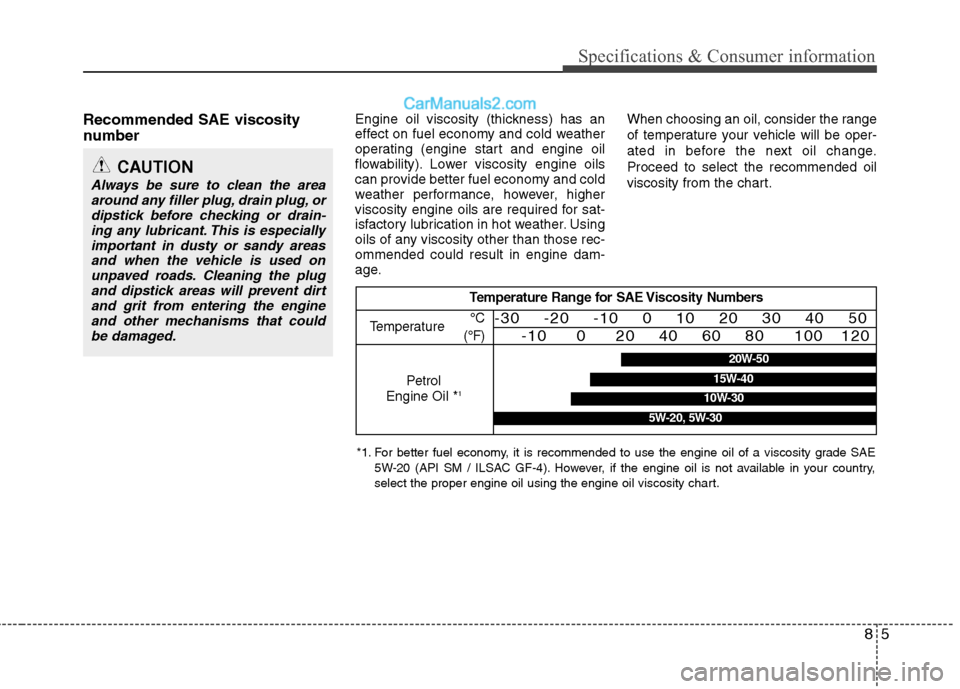
85
Specifications & Consumer information
Recommended SAE viscosity
number Engine oil viscosity (thickness) has an
effect on fuel economy and cold weather
operating (engine start and engine oil
flowability). Lower viscosity engine oils
can provide better fuel economy and cold
weather performance, however, higher
viscosity engine oils are required for sat-
isfactory lubrication in hot weather. Using
oils of any viscosity other than those rec-ommended could result in engine dam-
age.When choosing an oil, consider the range
of temperature your vehicle will be oper-
ated in before the next oil change.Proceed to select the recommended oil
viscosity from the chart.
CAUTION
Always be sure to clean the area
around any filler plug, drain plug, ordipstick before checking or drain-ing any lubricant. This is especially
important in dusty or sandy areasand when the vehicle is used onunpaved roads. Cleaning the plugand dipstick areas will prevent dirt
and grit from entering the engine and other mechanisms that couldbe damaged.
Temperature Range for SAE Viscosity Numbers
Temperature
Petrol
Engine Oil * 1°C
(°F)-30 -20 -10 0 10 20 30 40 50 -10 0 20 40 60 80 100 120
*1. For better fuel economy, it is recommended to use the engine oil of a viscosity grade SAE5W-20 (API SM / ILSAC GF-4). However, if the engine oil is not available in your country,
select the proper engine oil using the engine oil viscosity chart.
20W-50
10W-30
15W-40
5W-20, 5W-30